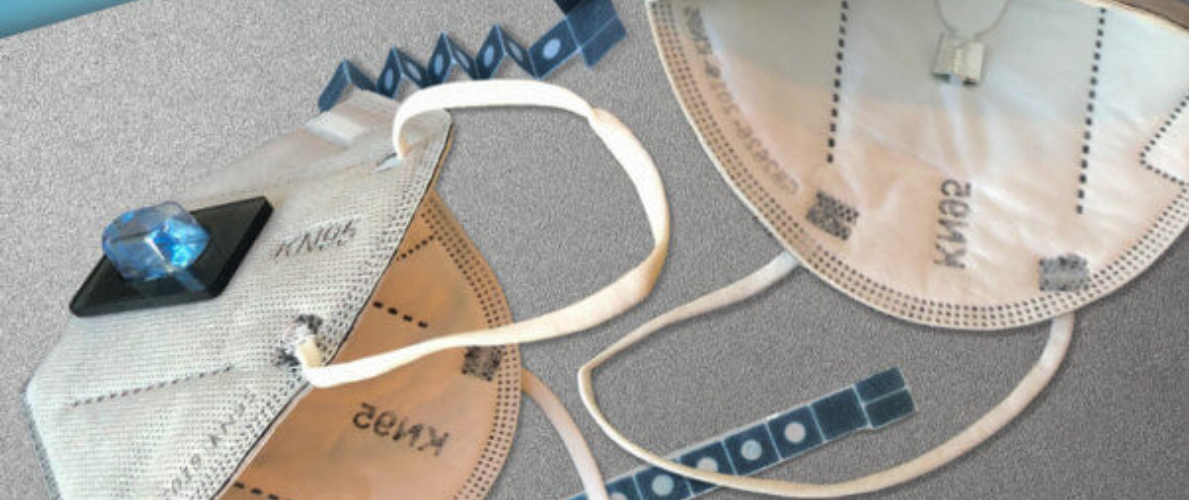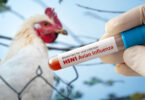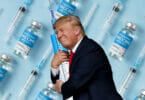The following report is from Study Finds:
A new type of face mask can actually detect COVID-19 infections. Engineers from the Massachusetts Institute of Technology (MIT) say their mask can diagnose the wearer with COVID in just 90 minutes.
The prototype sensor technology could also be used to create clothes that detect the virus as well as a variety of other pathogens, according to study authors. Researchers say they embedded face masks with tiny, disposable sensors that can fit into various types of coverings and need little adjusting in order to scan for other germs.
The sensors are based on freeze-dried cellular machinery that the research team has previously developed for use in paper diagnostics for viruses such as Ebola and Zika. In the new study, the researchers showed that the sensors could be not only improve face masks, but also clothing such as lab coats. This potentially offers a new way to monitor health care workers’ exposure to a variety of pathogens at medical facilities.
We’ve demonstrated that we can freeze-dry a broad range of synthetic biology sensors to detect viral or bacterial nucleic acids, as well as toxic chemicals, including nerve toxins.
We envision that this platform could enable next-generation wearable biosensors for first responders, health care personnel, and military personnel.
Study senior author Professor James Collins says in a university release.
Technology Years In The Making
Collins adds that the face mask sensors are designed so that the wearer can activate them when they’re ready to perform the test. The results are only displayed on the inside of the mask, for user privacy. The new wearable sensors and diagnostic face mask are based on technology that Prof. Collins began developing several years ago.
In 2014, he showed that proteins and nucleic acids needed to create synthetic gene networks that react to specific target molecules could be embedded into paper. He used this approach to create paper diagnostics for the Ebola and Zika viruses.
More recently, Prof. Collins and his colleagues began working on incorporating sensors into textiles, with the goal of creating a lab coat for health care workers or others at risk of exposure to pathogens. To make wearable sensors, the researchers embedded their freeze-dried components into a small section of synthetic fabric, where they are surrounded by a ring of silicone elastomer.
They showed that a small splash of liquid containing viral particles, mimicking exposure to an infected patient, can hydrate the freeze-dried cell components and activate the sensor. The sensors can be designed to produce different types of signals, including a color change that can be seen with the naked eye. The researchers also designed a wearable spectrometer that could be integrated into the fabric, where it can read the results and wirelessly transmit them to a mobile device.
This gives you an information feedback cycle that can monitor your environmental exposure and alert you and others about the exposure and where it happened.
Dr. Peter Nguyen, a research scientist at Harvard University’s Wyss Institute for Biologically Inspired Engineering.
COVID Provided The Perfect Testing Ground
As the researchers were finishing up their work on the wearable sensors early in 2020, COVID-19 began spreading around the world. The team quickly decided to try using their technology to create a diagnostic for the SARS-CoV-2 virus.
The sensors are placed on the inside of the mask, so they can detect viral particles in the breath of the person wearing the mask. The mask also includes a small reservoir of water that is released at the push of a button when the wearer is ready to perform the test.
Study authors say the water hydrates the freeze-dried components of the SARS-CoV-2 sensor, which analyzes accumulated breath droplets on the inside of the mask and produces a result within 90 minutes.
This test is as sensitive as the gold standard, highly sensitive PCR tests, but it’s as fast as the antigen tests that are used for quick analysis of Covid-19.
Dr. Peter Nguyen
The prototypes have sensors on the inside of the mask to detect a user’s status, as well as sensors placed on the outside of garments, to detect exposure from the environment. Scientists can also swap in sensors for other pathogens, including influenza, Ebola, and Zika, or sensors they have developed to detect organophosphate nerve agents.
Face Mask Sensors In Stores Soon?
The team has also filed for a patent on the technology and they are now hoping to work with a company to further develop the sensors. Prof. Collins believes the face mask is most likely the first application that could become available to consumers.
I think the face mask is probably the most advanced and the closest to a product. We have already had a lot of interest from outside groups that would like to take the prototype efforts we have and advance them to an approved, marketed product.
The findings appear in the journal Nature Biotechnology.
AUTHOR COMMENTARY
[20] O Timothy, keep that which is committed to thy trust, avoiding profane and vain babblings, and oppositions of science falsely so called: [21] Which some professing have erred concerning the faith. Grace be with thee. Amen. 1 Timothy 6:20-21
I honestly get so tired of repeating this, but it is, I believe, imperative to continually remind people of the facts and hopefully educate someone who does not know the facts, and is new to The WinePress: the virus has yet to be isolated, which is a critical and necessary tenant of virology. Therefore, if the original strain is not isolated to begin with, then there is no way to properly isolate any variant and evolved strands.
On top of that, if there is no isolate, then how do you test for it? You can’t. And then, to further compound on the deception, the PCR test was never designed for acute illness such as coronaviruses, and the test itself can be altered to skew the data results.
All this and and so much more can be found in our comprehensive report, “Facts Are Facts: Learn The Data Surrounding Covid-19.”
Needless to say, masking will not be going away for a while, and we shall see if this mask, or others, get major widespread use and attention.
World Economic Forum Promotes ‘The Mask Of The Future’
L.A. Urges The Vaccinated To Wear Masks Because Of Delta. Media Pushes “Reverse-Propaganda”
Razer’s New Ridiculous Hi-Tech Mask
[7] Who goeth a warfare any time at his own charges? who planteth a vineyard, and eateth not of the fruit thereof? or who feedeth a flock, and eateth not of the milk of the flock? [8] Say I these things as a man? or saith not the law the same also? [9] For it is written in the law of Moses, Thou shalt not muzzle the mouth of the ox that treadeth out the corn. Doth God take care for oxen? [10] Or saith he it altogether for our sakes? For our sakes, no doubt, this is written: that he that ploweth should plow in hope; and that he that thresheth in hope should be partaker of his hope. (1 Corinthians 9:7-10).
The WinePress needs your support! If God has laid it on your heart to want to contribute, please prayerfully consider donating to this ministry. If you cannot gift a monetary donation, then please donate your fervent prayers to keep this ministry going! Thank you and may God bless you.








I know exactly what to do with that piece of junk mask:
*Tosses it into a landfill
Oh, what a shame. I was planning on taking selfies with it. (Sarcasm)
Look at this crap from CNN… a health “expert” saying that the unvaccinated are potential variant factories… *eyeroll*
https://www.cnn.com/2021/07/03/health/unvaccinated-variant-factories/index.html
Wow, for those who can’t see we are truly in the end times, I don’t know what else to say.